Tuesday Dec 09, 2025
Tuesday Dec 09, 2025
Monday, 16 December 2024 03:47 - - {{hitsCtrl.values.hits}}
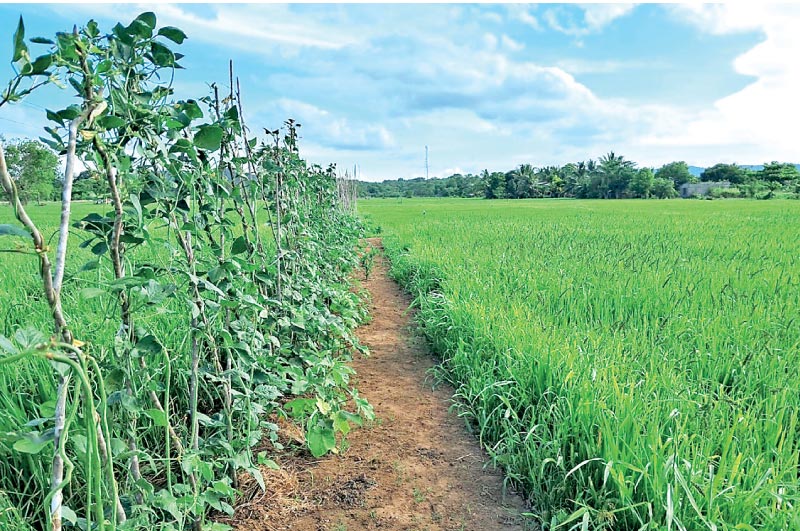
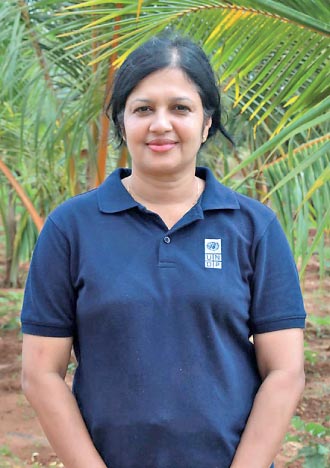 |
| CRIWMP Climate Smart Agriculture Program Coordinator Dr. Geethika Wijesundara |
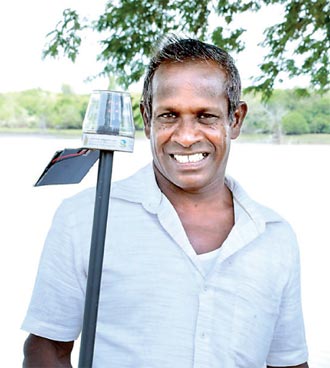 |
| Palugaswewa Farmer Organisation President R.B.M. Anura Wasantha with Sensoring AWD |
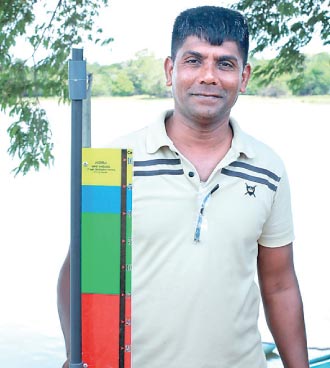 |
| Palugaswewa Farmer Organisation Secretary Susantha with Arrow AWD
|
For centuries, rice has been the heartbeat of Sri Lankan agriculture, with over 1 million hectares of paddy fields cultivated annually, accounting for 37% of the country’s land use. But as climate change accelerates, the task of managing water resources, especially for paddy, has become ever more challenging.
The Green Climate Fund-financed Climate Resilient Integrated Water Management Project (CRIWMP) is responding to this challenge with an innovative solution – Alternate Wetting and Drying (AWD). The project, implemented by the Government of Sri Lanka, with technical support from the United Nations Development Program (UNDP) in Sri Lanka, is transforming agricultural productivity, through integrated water
management.
A solution rooted in tradition and innovation
Paddy fields have long been cultivated under the continuous flooding system, consuming around 2,500 litres of water to produce just 1 kilogram of rice, placing immense pressure on water resources, especially during periods of drought.
Data from the project shows that through AWD, water usage is reduced by upto 27%, and increased cropping intensity from 1.2 to 2.1, which means farmers can now cultivate their land more frequently, leading to more harvests, more income, and food security.
Empowering farmers through knowledge and innovation
The success of this initiative is not just about introducing technology; it is about empowering Sri Lankan farmers with knowledge. The CRIWMP has worked closely with farming communities, providing them with training, tools, and climate advisory services to adopt the AWD system effectively.
Take for example, the case of the Palugaswewa Farmer Organisation. President R.B.M. Anura Wasantha shared that, prior to the project’s intervention, they could only cultivate their land to its full extent during the Maha (major) season and just a fraction during the Yala (minor) season.
The introduction of AWD technology has been a game-changer. Using simple tools like water pipes buried in the soil, farmers learned to monitor water levels and irrigate only when necessary. Agro-metrological advisories helped synchronise rainwater with their irrigation needs, ensuring that tank water is preserved for critical periods.
“Earlier, we used tank water for land preparation without understanding ‘on-farm and off-farm’ water management and were not familiar with agro-meteorological advisories either. Now, thanks to the depth gauge that has been installed, we can calculate the tank water levels accurately and follow the advisories to make better use of rainwater, conserving a big proportion of the irrigation water in the tank.”
“Now, we save the water in our tanks – it is like saving money in a bank for us,” says Wasantha, who proudly states that this practice has allowed them to cultivate their land fully even during the Yala season.
Advancing water management with technology
As the AWD method became more established, the CRIWMP took it a step further by introducing two advanced technologies – the Sensor Light System and the Water Level Arrow Marking System.
The Sensor Light System uses solar-powered sensors to monitor water levels. When the water level reaches a critical point, a red light switches on, signalling farmers to irrigate. The Water Level Arrow Marking System, on the other hand, uses a floating arrow that indicates water levels. Farmers can easily observe the water level from a distance, reducing the need to enter the field.
These innovations have enabled farmers like Wasantha to feel more confident in managing their water resources, even referring to themselves as “smart” farmers.
A paradigm shift in sustainable paddy farming
CRIWMP Climate Smart Agriculture Program Coordinator Dr. Geethika Wijesundara sees this transformation as a paradigm shift in water management for Sri Lanka’s paddy cultivation.
She explains: “By adopting AWD, farmers can now cultivate with just 2.9 to 3 acre-feet of water. This reduction means that water saved can be allocated to other field crops (OFCs) for a third season, leading to more yields and income.”
Palugaswewa Farmer Organisation Secretary Susantha shares: “We cultivated 100% of our Yala land with AWD. Along with agro-meteorological advisories, we used only the necessary amount of water for paddy cultivation. After the Maha season, we had 240 acre-feet of water left in the tank, and we received more from the rains. So, for the Yala season, we were able to use water for both paddy and green gram. We still have 30 acre-feet of water left in the tank for our domestic purposes.”
A win for the environment and future generations
The impact of AWD goes beyond water conservation and paddy productivity. Methane emissions, a significant contributor to global warming, have been reduced by 40% in fields adopting the AWD system. In Sri Lanka, studies note that the average methane emission rate in flooded paddy fields is 570 mg/ha, which have been reduced to an impressive 325 mg/ha through AWD. Dr. Wijesundara explains: “This has opened our eyes to the fact that integrated water management in paddy farming is essential. If AWD is adopted across Sri Lanka’s paddy farming fields, we could potentially reduce methane emissions by 245,000 tons annually.”
As the CRIWMP continues to introduce and promote innovative water management technologies, it is clear that the future of Sri Lankan paddy farming is becoming brighter, more sustainable, and more resilient.
Susantha attests: “I never knew that paddy fields emit methane. Thanks to the CRIWMP, we learned about methane emissions and now, I am proud to say that we are working on reducing our contributions to global warming.”
The road ahead
Taking AWD a step further, the project plans to conduct soil drainage class mapping in two village irrigation systems’ Yala programs, to determine the most optimal crop plan for the Yala season. This will ensure that paddy is cultivated based on water availability, while OFCs with higher market value are introduced, enhancing smallholders’ resilience and profitability, ensuring that they thrive in a changing climate.
Sri Lanka’s journey towards climate-resilient agriculture is a testament to the power of blending traditional knowledge with modern technology. By embracing change and innovation, Sri Lankan farmers are not just growing rice – they are cultivating hope, resilience, and a sustainable future for generations to come.
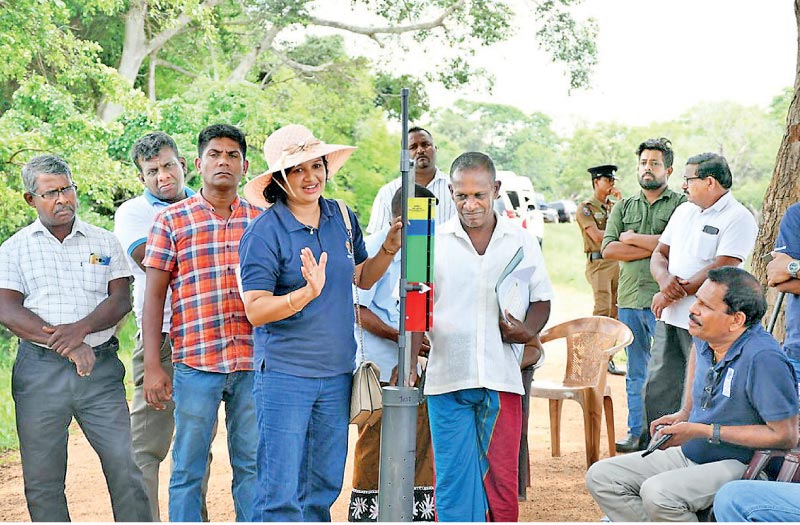
Explaining AWD to the Farmers' Organisation
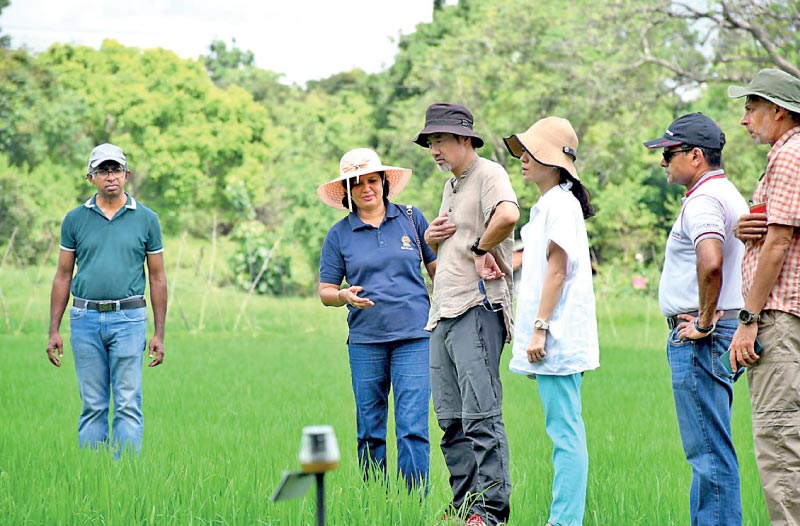
Joint partner field visit with reps from the Govt., ADB, UNDP, DFCC, and CSOs